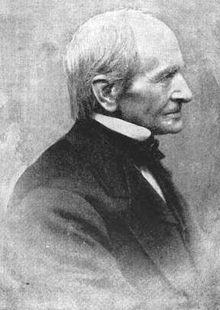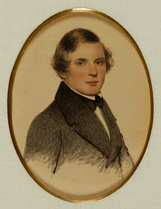Alvan Clark
| Alvan Clark | |
|---|---|
 | |
| Born |
March 8, 1804 Ashfield, Massachusetts |
| Died | August 19, 1887 (aged 83) |
| Nationality | American |
| Fields | Astronomy |
| Notable awards | Lalande Prize (1862) |
Alvan Clark (March 8, 1804 – August 19, 1887), born in Ashfield, Massachusetts, the descendant of a Cape Cod whaling family of English ancestry, was an American astronomer and telescope maker. He was a portrait painter and engraver (ca.1830s-1850s), and at the age of 40 became involved in telescope making. Using glass blanks made by Chance Brothers of Birmingham and Feil-Mantois of Paris, his firm Alvan Clark & Sons ground lenses for refracting telescopes, including the largest in the world at the time: the 18.5-inch (47 cm) at Dearborn Observatory at the Old University of Chicago (the lens was originally intended for Ole Miss), the two 26-inch (66 cm) telescopes at the United States Naval Observatory and McCormick Observatory, the 30-inch (76 cm) at Pulkovo Observatory (destroyed in the Siege of Leningrad; only the lens survives), the 36-inch (91 cm) telescope at Lick Observatory (still third-largest) and later the 40-inch (100 cm) at Yerkes Observatory, which remains the largest successful refracting telescope in the world. One of Clark's sons, Alvan Graham Clark, discovered the dim companion of Sirius. His other son was George Bassett Clark; both sons were partners in the firm.
Two craters bear his name. The crater Clark on the Moon is jointly named for him and his son, Alvan Graham Clark, and one on Mars is named in his honor.

See also
- Alvan Clark & Sons
- List of astronomical instrument makers
- List of largest optical refracting telescopes
Image gallery
- Portraits by Clark
-

Portrait of an unidentified woman, ca.1835 (Metropolitan Museum of Art)
-

Portrait of John Pickering, ca.1840 (Museum of Fine Arts, Boston)
-

Portrait of Samuel Hall Gregory, ca.1840s (Smithsonian)
-

Portrait of Joseph Story, 1846 (Museum of Fine Arts, Boston)
References
- "Alvan Clark, Astronomy, Biographies". AllRefer.com.
- Deborah Jean Warner & Robert B. Ariail. Alvan Clark & Sons, Artists in Optics. ISBN 0-943396-46-8.
Further reading
- "Recent Deaths. Alvan Clark." Boston Daily Evening Transcript, 19 August 1887.
- "Autobiography of Alvan Clark." New-England Historical and Genealogical Register 43 (January 1889): 52-58.
- Warner, Deborah Jean. Alvan Clark & Sons, Artists in Optics. Washington, 1968.
External links
| Wikimedia Commons has media related to Alvan Clark. |
- National Gallery of Art has works by Clark